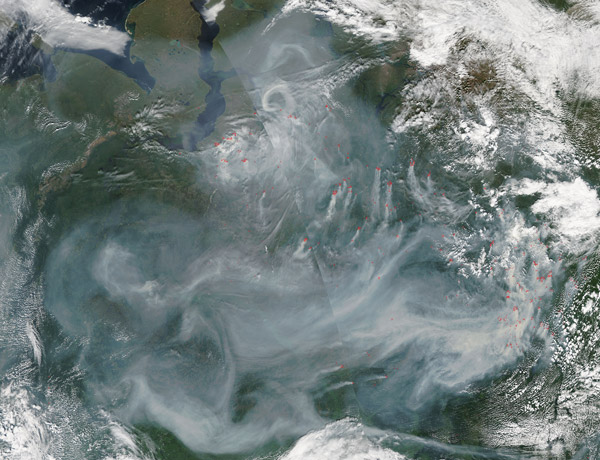Images
July 25, 2016 - Fires and smoke in central Russia
Tweet
In mid-July 2016, satellites observed dense smoke over north-central Russia. Many of the fires appeared in the tundra-taiga interface, where boreal forest give way to low-lying vegetation and permafrost.
The Moderate Resolution Imaging Spectroradiometer (MODIS) aboard NASA's Aqua satellite captured this true-color image of smoke and fire across north-central Russia on July 15. Red marks show hot spots, indicating high surface temperature caused by fire. /p>
The northernmost hotspots, especially those accompanied by dense smoke, are likely peat fires. Peatlands cover between two to three percent of the planet's land surface, but store 25 percent of the planet's soil carbon, according to a paper in Nature Geoscience.
In the Yamalo-Nenets Autonomous District (top-left sector) the flames burn north of the tree line (in the tundra, where low temperatures and a short growing season limit tree growth). Here, peat moss thrives, and snow blankets the ground for much of the year. The first flurries typically fall in early September, at the end of fire season. The tundra is an important carbon sink, storing greenhouse gases in its soils. But the tundra is vulnerable to rising global temperatures, which dry out peat and turn it into prime kindling for wildfire. Fires in the far north, particularly in peatlands, produce huge quantities of carbon dioxide and methane, further fueling global warming.
Because of its vast scale and remote locale, the area poses challenges to field research and makes satellite data particularly valuable to researchers, noted Jessica McCarty-Kern, a scientist at the Michigan Tech Research Institute in an interview with NASA's Earth Observatory.
�In order to know what�s going on in the entire Arctic, you can�t leave out Russia, because Russia is one-ninth of world�s landmasses,� said McCarty-Kern. Russia spans a much larger Arctic area than Alaska, Canada�s Nunavut and Northwest Territories.
Fires hinder the ecosystem�s ability to hold carbon. The blaze produces huge quantities of CO2 and methane (a potent greenhouse gas) into the air. Instead of holding carbon, the ground releases it, further warming the earth.
The autonomous district is home to the Yamalo-Nenets indigenous people, who live a semi-nomadic lifestyle and herd reindeer. The area is also a petrostate with massive gas and oil reserves, much like the North Slope of Alaska. Resource extraction in this area is lucrative, but it alters the landscape. Infrastructure like roads and pipelines can reduce the amount of soil moisture, making the ground more vulnerable to peat fires.
Image Facts
Satellite:
Aqua
Date Acquired: 7/16/2016
Resolutions:
1km (1.3 MB), 500m (4.4 MB), 250m (10.6 MB)
Bands Used: 1,4,3
Image Credit:
Jeff Schmaltz, MODIS Land Rapid Response Team, NASA GSFC
Tweet
In mid-July 2016, satellites observed dense smoke over north-central Russia. Many of the fires appeared in the tundra-taiga interface, where boreal forest give way to low-lying vegetation and permafrost.
The Moderate Resolution Imaging Spectroradiometer (MODIS) aboard NASA's Aqua satellite captured this true-color image of smoke and fire across north-central Russia on July 15. Red marks show hot spots, indicating high surface temperature caused by fire. /p>
The northernmost hotspots, especially those accompanied by dense smoke, are likely peat fires. Peatlands cover between two to three percent of the planet's land surface, but store 25 percent of the planet's soil carbon, according to a paper in Nature Geoscience.
In the Yamalo-Nenets Autonomous District (top-left sector) the flames burn north of the tree line (in the tundra, where low temperatures and a short growing season limit tree growth). Here, peat moss thrives, and snow blankets the ground for much of the year. The first flurries typically fall in early September, at the end of fire season. The tundra is an important carbon sink, storing greenhouse gases in its soils. But the tundra is vulnerable to rising global temperatures, which dry out peat and turn it into prime kindling for wildfire. Fires in the far north, particularly in peatlands, produce huge quantities of carbon dioxide and methane, further fueling global warming.
Because of its vast scale and remote locale, the area poses challenges to field research and makes satellite data particularly valuable to researchers, noted Jessica McCarty-Kern, a scientist at the Michigan Tech Research Institute in an interview with NASA's Earth Observatory.
�In order to know what�s going on in the entire Arctic, you can�t leave out Russia, because Russia is one-ninth of world�s landmasses,� said McCarty-Kern. Russia spans a much larger Arctic area than Alaska, Canada�s Nunavut and Northwest Territories.
Fires hinder the ecosystem�s ability to hold carbon. The blaze produces huge quantities of CO2 and methane (a potent greenhouse gas) into the air. Instead of holding carbon, the ground releases it, further warming the earth.
The autonomous district is home to the Yamalo-Nenets indigenous people, who live a semi-nomadic lifestyle and herd reindeer. The area is also a petrostate with massive gas and oil reserves, much like the North Slope of Alaska. Resource extraction in this area is lucrative, but it alters the landscape. Infrastructure like roads and pipelines can reduce the amount of soil moisture, making the ground more vulnerable to peat fires.
Image Facts
Satellite:
Aqua
Date Acquired: 7/16/2016
Resolutions:
1km (1.3 MB), 500m (4.4 MB), 250m (10.6 MB)
Bands Used: 1,4,3
Image Credit:
Jeff Schmaltz, MODIS Land Rapid Response Team, NASA GSFC




